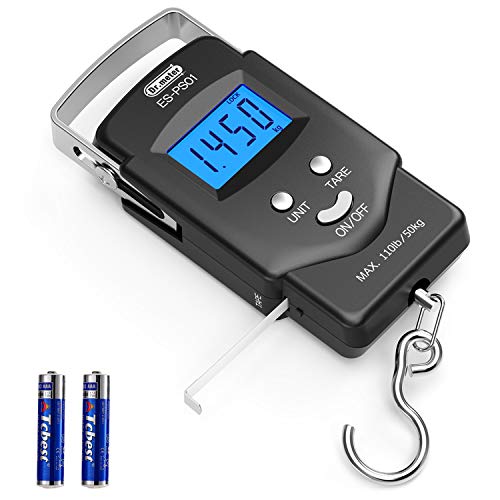I had a day off and was desperate to find some fish, so I called the Mossy Creek fly shop in hopes of booking some time on the inexpensive private water that they control. Since this was last minute, they were already booked and suggested that I go hit the South River in Waynesboro, as it had recently been stocked. Rumor had it that Virginia included some monster trout in the delayed harvest area. With that, I happily climbed into my truck and made the 2.5-hour drive from Northern Virginia to Waynesboro. I sure am glad that gas prices have become a lot more affordable over the last two months.
The delayed harvest area runs upstream for almost 2 1/2 miles from the 2nd St. Bridge. Not sure of where to go, I focused on the 2nd St., Bridge as my destination and was pleasantly surprised to discover that there is a city park immediately adjacent to the river just south of the bridge. The delayed harvest area is marked with a large wooden sign cautioning fishermen that special regulations exist. There is a beaten trail adjacent to the sign I followed; beating through the thick brush to get to the river.
The South River is broad and ran a foot or two deep on the day I visited in early November. Since it was getting colder, I hoped to use nymphs as an alternative to dry fly patterns. If there was an afternoon hatch, I could switch back if I saw fish rising. I concluded that, at this time of the year, you have to go below the surface to get to the fish. Unfortunately, the current in the South River was not vigorous enough to allow nymphs to float at the pace that I think results in a realistic presentation. So, I resorted to various streamer patterns, including woolly buggers and my favorite Patuxent Special.
About 100 yards of from my entry point, I tied into a large trout who eventually broke off. My assumption, of course, is that this thing had to be 100 inches long instead of the 13 he probably was — after all, any fish missed is automatically one for the record books. After that adrenaline bump, I was excited to continue to fish upstream. Even though the river is generally shallow, there are plenty of deeper areas that are sheltered by falling trees and shoreline brush that provide likely holding positions for trout. I continued to work upstream and began to hear the noise and smell the delightful odor of the lumber plant that borders the east bank of the river. I assumed that every vehicle in that plant could only be operated in reverse due to the constant beeping noise that blasted into the air.
While I don’t think that the noise impacted fishing, as the fish would eventually become accustomed to their environment, it certainly disrupted the ambiance of the river. I fished upstream for about a mile without any further action. Since it was not productive upstream from the access point, I decided to walk back down and fish downstream to the bridge. Clearly, the mental calculus was to try and discover the locations that permit stocking to occur. I’ve commented on this before, and you might think I learned my lesson. I need to bring a printed topographical map with me when I go to a new place. The detailed reconnaissance you can conduct to identify likely stock truck access points is critical to determine where the fish will be — particularly in a river that may not have anything except fallfish outside of stocking season.

Unfortunately, I had no better luck as I worked my way down to the bridge. There’s a good deep hole right underneath the bridge that I whipped for about half an hour with no results. Since this section is in the heart of a fairly large city, it’s reasonable to assume that it experiences considerable poaching in the areas that provide easy access. The 2nd St. Bridge has well beaten trails on either side that lead to this particular hole.
South River Trout Fishing Bottom line: Since the delayed harvest area stretches for 2 1/2 miles upstream from the 2nd St. Bridge, the next time I come here I will go to locations farther upstream where multiple bridges cross the river. That provides better access for stocking and, potentially, a higher density of fish. If you look at the map above, you can see that there were only two stocking access points in this section I fished. The first is at the bridge and the second is from the lumberyard itself. There is a high birm that runs along the west side of the bank that separates the river from the park. This presents a substantial barrier to stocking because fish would have to be carried over to birm to be inserted into the water. For that reason, I don’t think I will start fishing at the 2nd St. Bridge on my next trip.
Comment: I really wish trout fishing did not involve trying to second-guess where a stock truck can access the water. What I would rather see is that Virginia stock fish that live all year round, like smallmouth, instead of trout which will die off naturally in the summer. It’s a shame to have to dwell on this, but that’s our reality for now.
Getting There: Take exit 99 off of I64 north onto Rt 250. Follow 250 to Rt 340 and make a right. Turn left on 2nd Street and follow it to the river. Immediately beyond the turn (west side of the river), there is a park. Make a left into the park and go all the way to the last picnic area to the south. You will see the large sign marking the delayed harvest section on the birm next to the river.
Google Local Coordinates: 38.07867,-78.875699
Secrets Revealed? No. This is a very public location that is documented in the following places:
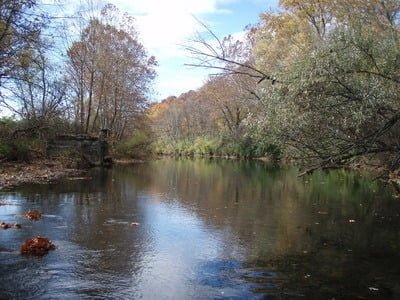
Upstream from the entry point
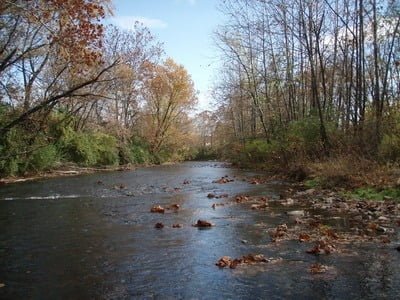
Downstream from the entry point
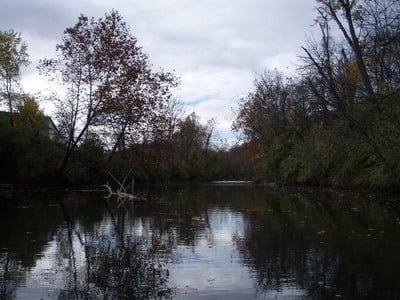
Flat, uninteresting water
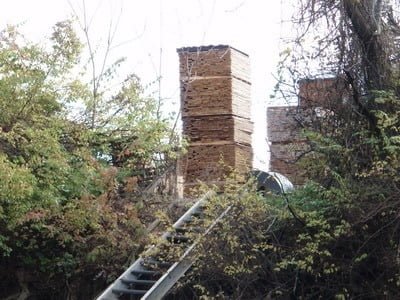
This section is right next to a lumber plant
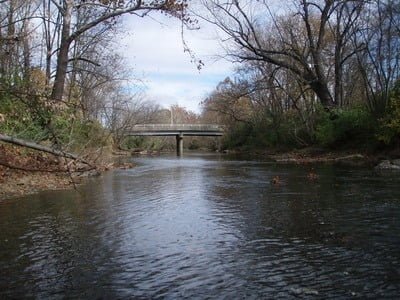
The bridge marks the downstream boundary of the delayed harvest area
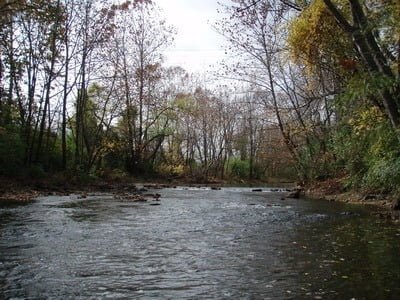
Looking upstream from the bridge
Unless stated otherwise, this article was authored by Steve Moore

